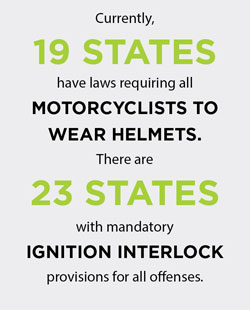Shutterstock
Mounting evidence shows that certain traffic safety countermeasures consistently save lives on our nation’s roadways. Examples include motorcycle helmet laws, primary enforcement of seat belt use, sobriety checkpoints, graduated driver licensing (GDL), mandatory ignition interlock, and automated speed enforcement. But despite the effectiveness of these countermeasures, states that have tried to implement them have had varying levels of success in gaining the support needed from policymakers.
A team of researchers from the U of M’s Humphrey School of Public Affairs is working to understand why this support varies so widely in a project funded by the Roadway Safety Institute. The team’s work includes assessing the factors that affect the adoption of evidence-based approaches to road safety by state legislators and policy leaders, examining the role of federally required state safety programs, and identifying best practices for states.
“We know that if certain policy countermeasures are adopted more broadly by state legislatures, we would likely see measurable and significant reductions in roadway fatalities and serious injuries,” says Lee Munnich, Humphrey School senior fellow and the project’s lead investigator. “In this project, we’re asking why state legislators and policy leaders support or oppose certain evidence-based countermeasures. For example, are they not convinced of the evidence? Are they concerned about constituent response? And how do things like public opinion surveys, lobbying groups, and law enforcement organizations affect their decisions in support or opposition?”
Earlier this year, Munnich’s team completed the first phase of the project, which included reviewing state strategic highway safety plans and Toward Zero Deaths (TZD) programs in Illinois, Indiana, Michigan, Minnesota, Ohio, and Wisconsin.
As part of that work, the researchers prepared a draft case study for each state. The case study on Minnesota, for example, found that the state has demonstrated mixed results in implementing policy countermeasures. Minnesota has been successful in legislating primary enforcement of seat belt use, GDL program upgrades, and mandated ignition interlock implementation in certain cases, but it does not require universal motorcycle helmet use or authorize automated speed enforcement or the use of sobriety checkpoints. This means the state legislature could do considerably more to make advances in those areas, the researchers say.
The team also developed methodology for a TZD program assessment tool and conducted policy interviews with state legislators and safety policy leaders. During the next year, continued work will include developing and testing the new TZD assessment tool, conducting roadway safety policy roundtables, and completing a policy brief.
Ultimately, Munnich hopes this work will help shape the future of roadway safety policy. “Safety strategies require policy leadership as well as institutional collaboration for continued improvements in roadway safety,” he says. “We hope that the assessment tool will help policymakers to reevaluate their positions to push for evidence-based road safety policy countermeasures.”
This research, he adds, will contribute to further developing and successfully implementing roadway safety policy strategies at the state and local level—in addition to providing best practices and strategies for legislators, state DOTs, public safety offices, and elected officials.




